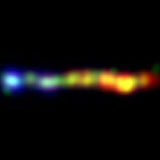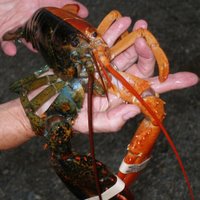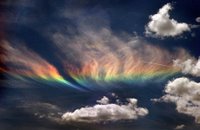
The brightest object in the Universe is showing its colors thanks to combined images from NASA's three space telescopes. In a photo released 21 July, a jet of high-speed particles shoots from the first known quasar, 3C273, which was discovered in 1963. The jet stretches 100,000 light-years, the diameter of the Milky Way galaxy. The colors represent X-rays (blue) recorded by the Chandra X-ray Observatory, visible light (green) imaged by the Hubble Space Telescope, and infrared (red) captured by the Spitzer Space Telescope. (Photo: NASA/JPL-Caltech/Yale University)

Recently a Maine lobsterman caught a lobster that looks half raw and half cooked. Half of the animal is mottled brown, while the other is bright orange—the color lobsters turn after they've been boiled. Experts explain that two-toned lobsters are rare but not unheard of. The shells of American, or Maine, lobsters usually sport a combination of yellow, red, and blue pigments. But the animals grow symmetrically, with each half of the body developing independently of the other.

The map (left) details the Andromeda galaxy's gas clouds—birthplaces of new stars. The galaxy (pictured at right) contains a trillion stars and is the nearest spiral galaxy to our own spiral, the Milky Way. Andromeda contains enough hydrogen gas clouds to form 360 million new suns, according to analysis of the new map, which is based on observations by a 98-foot-wide (30-meter-wide) radio dish in Granada, Spain. The map and an accompanying study appeared in the mid-July issue of the journal Astronomy and Astrophysics. Experts say that those regions are important, because that is where new stars are either currently forming or will soon form.

Known in the weather world as a circumhorizontal arc, this rare sight was caught on film on June 3 as it hung over northern Idaho near the Washington State border. The arc isn't a rainbow in the traditional sense—it is caused by light passing through wispy, high-altitude cirrus clouds. The sight occurs only when the sun is very high in the sky (more than 58° above the horizon). What's more, the hexagonal ice crystals that make up cirrus clouds must be shaped like thick plates with their faces parallel to the ground. This particular arc spanned several hundred square miles of sky and lasted for about an hour, according to the London Daily Mail.

In the northern Indian city of Lucknow, a mouse perches on a frog in waist-deep (for a frog, anyway) floodwaters—a small sign of the early arrival of annual summer monsoon rains. According to the Indo-Asian News Service, some rural Indians are holding frog weddings in the hopes that the amphibians' bliss will inspire farm-saving storms. After marking the bride and groom with vermillion and turmeric—traditional adornments in human Hindu nuptials—villagers take the supposedly happy couple to a nearby pond to honeymoon.
 The brightest object in the Universe is showing its colors thanks to combined images from NASA's three space telescopes. In a photo released 21 July, a jet of high-speed particles shoots from the first known quasar, 3C273, which was discovered in 1963. The jet stretches 100,000 light-years, the diameter of the Milky Way galaxy. The colors represent X-rays (blue) recorded by the Chandra X-ray Observatory, visible light (green) imaged by the Hubble Space Telescope, and infrared (red) captured by the Spitzer Space Telescope. (Photo: NASA/JPL-Caltech/Yale University)
The brightest object in the Universe is showing its colors thanks to combined images from NASA's three space telescopes. In a photo released 21 July, a jet of high-speed particles shoots from the first known quasar, 3C273, which was discovered in 1963. The jet stretches 100,000 light-years, the diameter of the Milky Way galaxy. The colors represent X-rays (blue) recorded by the Chandra X-ray Observatory, visible light (green) imaged by the Hubble Space Telescope, and infrared (red) captured by the Spitzer Space Telescope. (Photo: NASA/JPL-Caltech/Yale University) Recently a Maine lobsterman caught a lobster that looks half raw and half cooked. Half of the animal is mottled brown, while the other is bright orange—the color lobsters turn after they've been boiled. Experts explain that two-toned lobsters are rare but not unheard of. The shells of American, or Maine, lobsters usually sport a combination of yellow, red, and blue pigments. But the animals grow symmetrically, with each half of the body developing independently of the other.
Recently a Maine lobsterman caught a lobster that looks half raw and half cooked. Half of the animal is mottled brown, while the other is bright orange—the color lobsters turn after they've been boiled. Experts explain that two-toned lobsters are rare but not unheard of. The shells of American, or Maine, lobsters usually sport a combination of yellow, red, and blue pigments. But the animals grow symmetrically, with each half of the body developing independently of the other. The map (left) details the Andromeda galaxy's gas clouds—birthplaces of new stars. The galaxy (pictured at right) contains a trillion stars and is the nearest spiral galaxy to our own spiral, the Milky Way. Andromeda contains enough hydrogen gas clouds to form 360 million new suns, according to analysis of the new map, which is based on observations by a 98-foot-wide (30-meter-wide) radio dish in Granada, Spain. The map and an accompanying study appeared in the mid-July issue of the journal Astronomy and Astrophysics. Experts say that those regions are important, because that is where new stars are either currently forming or will soon form.
The map (left) details the Andromeda galaxy's gas clouds—birthplaces of new stars. The galaxy (pictured at right) contains a trillion stars and is the nearest spiral galaxy to our own spiral, the Milky Way. Andromeda contains enough hydrogen gas clouds to form 360 million new suns, according to analysis of the new map, which is based on observations by a 98-foot-wide (30-meter-wide) radio dish in Granada, Spain. The map and an accompanying study appeared in the mid-July issue of the journal Astronomy and Astrophysics. Experts say that those regions are important, because that is where new stars are either currently forming or will soon form. Known in the weather world as a circumhorizontal arc, this rare sight was caught on film on June 3 as it hung over northern Idaho near the Washington State border. The arc isn't a rainbow in the traditional sense—it is caused by light passing through wispy, high-altitude cirrus clouds. The sight occurs only when the sun is very high in the sky (more than 58° above the horizon). What's more, the hexagonal ice crystals that make up cirrus clouds must be shaped like thick plates with their faces parallel to the ground. This particular arc spanned several hundred square miles of sky and lasted for about an hour, according to the London Daily Mail.
Known in the weather world as a circumhorizontal arc, this rare sight was caught on film on June 3 as it hung over northern Idaho near the Washington State border. The arc isn't a rainbow in the traditional sense—it is caused by light passing through wispy, high-altitude cirrus clouds. The sight occurs only when the sun is very high in the sky (more than 58° above the horizon). What's more, the hexagonal ice crystals that make up cirrus clouds must be shaped like thick plates with their faces parallel to the ground. This particular arc spanned several hundred square miles of sky and lasted for about an hour, according to the London Daily Mail. In the northern Indian city of Lucknow, a mouse perches on a frog in waist-deep (for a frog, anyway) floodwaters—a small sign of the early arrival of annual summer monsoon rains. According to the Indo-Asian News Service, some rural Indians are holding frog weddings in the hopes that the amphibians' bliss will inspire farm-saving storms. After marking the bride and groom with vermillion and turmeric—traditional adornments in human Hindu nuptials—villagers take the supposedly happy couple to a nearby pond to honeymoon.
In the northern Indian city of Lucknow, a mouse perches on a frog in waist-deep (for a frog, anyway) floodwaters—a small sign of the early arrival of annual summer monsoon rains. According to the Indo-Asian News Service, some rural Indians are holding frog weddings in the hopes that the amphibians' bliss will inspire farm-saving storms. After marking the bride and groom with vermillion and turmeric—traditional adornments in human Hindu nuptials—villagers take the supposedly happy couple to a nearby pond to honeymoon.


0 Comments:
Post a Comment
<< Home